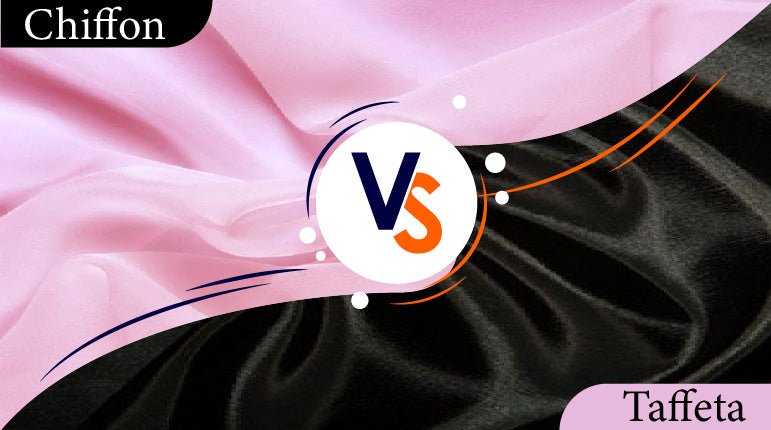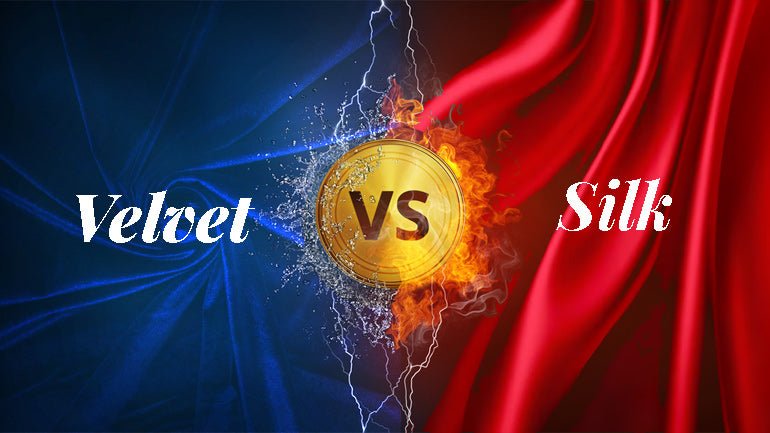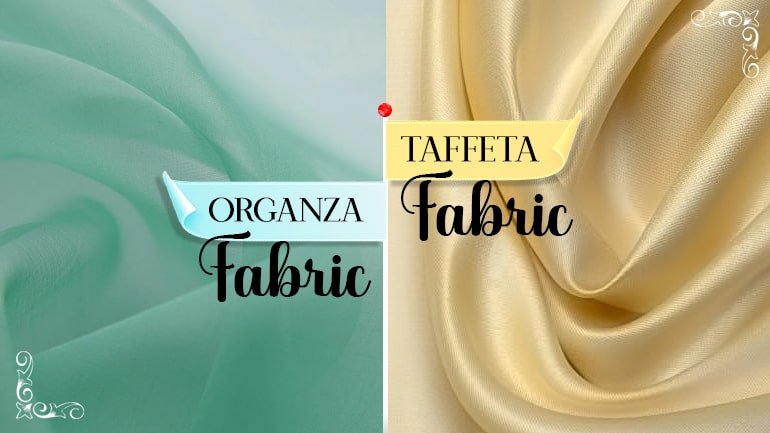Fashion changes day by day but some fabrics always stay on trend. The choice between chiffon and taffeta can often puzzle even the most seasoned fashion enthusiasts. These two materials, although both known for their elegance and grace, possess distinct qualities that set them apart.
Is chiffon similar to taffeta? This question is often asked by people when choosing both of these fabrics. Chiffon, renowned for its lightweight and flowing nature, induces a sense of ethereal elegance. Meanwhile, taffeta boasts a structured and polished appearance, characterized by its crisp texture and voluminous drape. Understanding the difference between chiffon and taffeta – from weight and texture to sheerness and drape – is crucial in selecting the perfect material for diverse design needs and occasions.
If you're contemplating the ideal fabric for a gown, a dress, or any other exquisite attire, understanding the disparities between chiffon and taffeta can greatly influence your selection.
Chiffon vs Taffeta: Which is Better Taffeta or Chiffon?
Weight Matters
One of the most noticeable differences between chiffon and taffeta is their weight. Chiffon is celebrated for its feather-light feel, making it an excellent choice for crafting garments that require flowing and delicate designs. Its weightless nature lends an ethereal touch to creations such as evening gowns, scarves, and blouses.
In contrast, taffeta carries a discernible weight that provides a sense of structure and presence to garments. While not as heavy as some other fabrics, taffeta's weight is particularly advantageous for formal designs and attire that demands volume or shape, like bridal gowns or evening dresses.
Texture
The texture of a fabric greatly influences its overall appearance and feel. Chiffon boasts a soft texture with a subtle roughness, contributing to its delicate and lightweight demeanor. This quality gives chiffon an air of romance and fluidity, making it a favored option for elegant garments and accessories.
On the flip side, taffeta exhibits a crisp and smooth texture, stemming from its tightly woven structure. This characteristic adds a sense of luxury and polish to the fabric, rendering it ideal for formalwear and decorative items.
Sheerness
Sheerness is a key attribute that sets chiffon and taffeta apart. Chiffon is renowned for its sheer quality, allowing light to pass through and creating a see-through effect. This inherent transparency infuses garments with a sensual and feminine allure, often necessitating layering or lining to maintain modesty or desired coverage.
Taffeta, on the contrary, is not sheer; its opacity means it doesn't allow light to penetrate. Taffeta's full coverage eliminates the need for additional layers or lining, simplifying the design process.
Drapery
The way a fabric drapes plays a pivotal role in shaping the overall look of a garment. Chiffon features a soft and flowing drape, a result of its lightweight and loosely woven nature. This lends a graceful and fluid movement to chiffon garments, creating an elegant and ethereal silhouette.
Taffeta, with its more structured drape, contrasts with chiffon's flow. The fabric holds its shape firmly, delivering a stiffer and more pronounced silhouette. This structured drape is particularly beneficial for designs that require volume or defined lines.
Sound
The sounds fabrics make as they move contribute to the sensory experience of wearing or interacting with them. Chiffon produces a silent or muted sound, underscoring its soft and lightweight composition. This minimal sound generation directs attention to the visual appeal and delicate texture of chiffon.
On the other hand, taffeta is known for its characteristic rustling sound, a result of its crisp texture. This sound enhances the luxurious and high-quality perception associated with taffeta, contributing to its allure.
Appearances
The appearance of a fabric significantly influences the overall impression of a garment. Chiffon projects a delicate and ethereal aesthetic, marked by its soft texture and slightly rough surface. It often finds its home in evening gowns, blouses, scarves, and other designs that require a soft and graceful allure.
Taffeta’s smooth and crisp texture, combined with a tightly woven structure, makes taffeta suitable for bridal gowns, formalwear, curtains, and other items that demand sophistication and elegance.
Common Uses
The intended application of a fabric often dictates its characteristics and properties. Chiffon is frequently employed in creating elegant and airy garments. It can be found in evening gowns, bridesmaid dresses, scarves, blouses, and overlays. Chiffon's sheer and lightweight nature makes it a preferred choice for designs that require flowing and draping elements.
Taffeta, on the other hand, is primarily reserved for formal and special occasion wear. Its structured drape and lustrous appearance lend themselves well to bridal gowns, evening dresses, ball gowns, and formal suits.
Material Options
Both chiffon and taffeta can be manufactured using a variety of materials, but their choices significantly impact their attributes. Chiffon is often made from synthetic fibers like polyester or nylon, offering durability, easy care, and affordability. These synthetic materials maintain the lightweight and sheer qualities of chiffon.
Taffeta can be crafted from silk, polyester, nylon, acetate, and other synthetic fibers. Silk taffeta is renowned for its luxurious feel, while synthetic variants provide a more budget-friendly alternative without sacrificing appearance and durability.
Feel
The tactile sensation a fabric imparts is an essential aspect of its overall charm. Chiffon has a silky and smooth feel, even with its lightweight nature. This quality provides an elegant and delicate sensation when worn.
Taffeta has a smooth and slightly crisp touch, differs from chiffon due to its tightly woven structure. Taffeta's tactile experience exudes a sense of substance and quality, contributing to its allure when touched or worn.
Structure
The structural makeup of a fabric determines its ability to hold shapes and maintain its form. Chiffon features a soft and loosely woven structure that allows for graceful movement and relaxed silhouettes.
Taffeta, with its tightly woven composition, has a structured nature that retains its shape, giving garments a more pronounced and defined silhouette. Taffeta's structure is ideal for creating volume, crispness, and a sense of formality in designs.
Wrinkling
One of the most apparent differences between chiffon and taffeta lies in their susceptibility to wrinkles. Chiffon, a lightweight and delicate fabric, is known for its propensity to wrinkle and crease. Its ethereal nature requires careful handling and storage to minimize unsightly wrinkles. When packing chiffon garments for travel or storage, experts recommend rolling them rather than folding, as this helps reduce the appearance of wrinkles.
Taffeta, on the other hand, displays a more robust resistance to wrinkles. The tightly woven and structured composition of taffeta lends it a smooth and crisp appearance, minimizing the formation of wrinkles. In essence, taffeta garments generally demand less effort to retain their wrinkle-free elegance.
Shaping
Shaping a garment involves the fabric's ability to hold its form and structure. Chiffon naturally drapes and flows, making it better suited for designs emphasizing fluidity and movement over precise shaping.
Taffeta is known for its capacity to hold shapes and provide structure. Its stiffness and body enable the maintenance of volume and defined silhouettes, making it an ideal choice for designs with pleats, architectural details, or well-defined lines.
Breathability
The breathability of a fabric impacts its comfort in various weather conditions. Chiffon is breathable due to its lightweight and loosely woven structure, allowing air to flow through. This feature makes it a comfortable option for warmer weather, as it prevents overheating and provides a cool sensation.
Taffeta, however, is less breathable due to its tightly woven nature, restricting the flow of air. It's better suited for cooler climates or occasions where breathability is not a primary concern.
Durability
Another noticeable discrepancy between chiffon and taffeta lies in their durability. Chiffon, with its delicate and lightweight constitution, is inherently less robust when compared to taffeta. Its fine weave makes it susceptible to snags, tears, and fraying. As a result, chiffon garments necessitate cautious handling and gentle care to ensure their longevity.
On the other hand, taffeta boasts a sturdier structure due to its tightly woven texture. This characteristic imparts it with the ability to withstand wear and tear more effectively than chiffon. Taffeta's resilience makes it a prudent choice for clothing items that demand longevity and resistance to potential damage.
Care
When it comes to care, chiffon and taffeta have differing demands. Chiffon, being the more delicate of the two, often requires special attention during washing. Hand washing or employing the gentle cycle of a washing machine is the recommended approach for maintaining the integrity of chiffon garments. The fragility of the fabric mandates careful handling to prevent stretching, snagging, or any form of deterioration.
Get the complete story on How to Wash Chiffon Fabric.
Taffeta, in contrast, proves to be more forgiving in terms of care. Its robust nature allows it to endure regular machine washing, making it less high-maintenance than chiffon. However, care instructions may vary based on the specific fiber used in taffeta production, so it's advisable to refer to the garment's care label for guidance.
Expand your knowledge with the Guide About How to Wash Taffeta Fabric.
Price
The price differential between chiffon and taffeta is another aspect to consider. Chiffon, often produced using synthetic fibers like polyester or nylon, tends to be more budget-friendly. The utilization of these materials makes chiffon an economical choice for crafting lightweight, flowing garments without compromising on style.
In contrast, taffeta's association with opulent and formal designs, coupled with its utilization of premium materials such as silk, contributes to its higher price point. Taffeta's exquisite quality and refined appearance justify its position as a pricier option within the fabric market.
Formality
The level of formality that chiffon and taffeta is another pivotal factor in the decision-making process. Chiffon, with its versatility, seamlessly transitions between casual and formal occasions. It is a staple in elegant evening wear and formal gowns, but it is equally adept at enhancing relaxed or everyday styles. Chiffon's adaptability facilitates a wide range of designs, spanning from simple and casual to glamorous and sophisticated.
Taffeta, however, is predominantly synonymous with formal and exceptional events. Its polished and structured appearance makes it an ideal choice for bridal gowns, ball gowns, and other upscale attire. Taffeta's innate elegance and refinement render it the fabric of choice for occasions demanding a heightened level of formality and sophistication.
Layering
The distinct textures of chiffon and taffeta lead to their differing aptitudes for layering. Chiffon's lightweight and sheer quality makes it an ideal fabric for layering purposes. Designers often use chiffon to create overlays, ruffles, or multiple layers within garments. These chiffon layers add dimension, movement, and a touch of romance to designs, making it a popular choice for enhancing the visual depth of an ensemble.
Taffeta, due to its more rigid and voluminous nature, is less frequently utilized in layering techniques. Its stiffness makes it a natural candidate for statement pieces, rather than serving as an underlayer under other fabrics.
Color Vibrancy
Color vibrancy is another domain in which chiffon and taffeta diverge. Chiffon fabrics tend to exhibit softer and more muted color tones. The sheer and light-reflecting properties of chiffon impart a delicate and subtle appearance to the colors. Pastel shades and dreamy hues are commonly associated with chiffon, contributing to its ethereal aesthetic.
On the contrary, taffeta boasts vibrant and intense color saturation. Its smooth and lustrous surface enables colors to appear rich, bold, and highly saturated. Taffeta's vivid color palette heightens its luxurious and eye-catching allure, making it a preferred choice for formalwear that demands attention.
Sustainability
In the modern age, sustainability is a critical consideration in fabric choices. Chiffon, particularly when made from synthetic fibers, relies on non-renewable petroleum oil. However, ongoing efforts in the textile industry aim to develop more sustainable alternatives, such as recycled polyester or bio-based fibers, to mitigate the environmental impact.
Taffeta's sustainability depends on the materials used in its production. Silk taffeta is natural and biodegradable, but it requires raising and harvesting silk worms. Synthetic taffeta options can incorporate recycled fibers to reduce their impact. The sustainability of both fabrics varies based on material choices and manufacturing processes.
Also read for Taffeta vs. Satin.
Chiffon vs Taffeta: Comparison Table
|
Feature |
Chiffon |
Taffeta |
|
Weight |
Feather-light, excellent for flowing designs |
Discernible weight, adds structure to garments |
|
Texture |
Soft with subtle roughness, delicate |
Crisp and smooth, exudes luxury |
|
Sheerness |
Sheer, see-through effect |
Not sheer, offers full coverage |
|
Drapery |
Soft and flowing, elegant movement |
Structured drape, holds shape firmly |
|
Sound |
Silent or muted, emphasizes texture |
Characteristic rustling sound, adds allure |
|
Appearance |
Delicate and ethereal |
Opulent and polished |
|
Common Uses |
Evening gowns, scarves, blouses, overlays |
Bridal gowns, evening dresses, formalwear |
|
Material Options |
Polyester, nylon |
Silk, polyester, nylon, acetate |
|
Feel |
Silky and smooth |
Smooth and slightly crisp |
|
Structure |
Loosely woven, relaxed silhouettes |
Tightly woven, pronounced silhouette |
|
Wrinkling |
Prone to wrinkles, requires careful handling |
Resistant to wrinkles, maintains crispness |
|
Shaping |
Emphasizes fluidity and movement |
Holds shapes and provides structure |
|
Breathability |
Breathable, suitable for warmer weather |
Less breathable, better for cooler climates |
|
Durability |
Delicate, susceptible to snags and tears |
Sturdy, resists wear and tear effectively |
|
Care |
Hand wash or gentle cycle recommended |
Regular machine washing, less high-maintenance |
|
Price |
Budget-friendly |
Higher price point, associated with luxury |
|
Formality |
Versatile, transitions between casual and formal |
Predominantly formal and upscale occasions |
|
Layering |
Ideal for layering, adds dimension and romance |
Less suited for layering, stiffness preferred |
|
Color Vibrancy |
Soft and muted tones |
Intense color saturation, bold appearance |
|
Sustainability |
Efforts for more sustainable alternatives |
Depends on material choice and manufacturing |
Final words
Chiffon and taffeta, though belonging to the same family of textiles, are worlds apart in their characteristics and applications. The differences in weight, texture, sheerness, drape, and other attributes have made these fabrics indispensable in the world of fashion, enabling designers to bring their creative visions to life with fabrics tailored to the occasion and style.
Faqs
Can chiffon and taffeta fabrics be used interchangeably in garments?
Chiffon and taffeta fabrics have distinct qualities, making them less interchangeable; chiffon is light and flowing, while taffeta is structured and polished, suited to different design needs.
Are chiffon and taffeta fabrics suitable for all seasons?
Chiffon is breathable and suitable for warmer seasons, while taffeta's tight weave may be better for cooler weather, offering varied seasonal suitability.
Can chiffon and taffeta fabrics withstand frequent washing and wearing?
Chiffon's delicate nature calls for cautious washing, while taffeta's sturdiness allows for more frequent washing and wearing, respectively.



